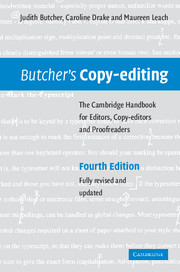Book contents
- Frontmatter
- Contents
- List of illustrations
- Preface to the fourth edition
- Preface to the third edition
- Preface to the second edition
- Preface to the first edition
- Acknowledgements
- 1 Introduction
- 2 Preliminary copy-editing, design and specimen pages
- 3 Preparing the text for the typesetter
- 4 Illustrations
- 5 Proofs
- 6 House style
- 7 Preliminary pages
- 8 Indexes
- 9 Other parts of a book
- 10 Bibliographical references
- 11 Literary material
- 12 Multi-author and multi-volume works
- 13 Science and mathematics books
- 14 Other special subjects
- 15 Reprints and new editions
- 16 On-screen editing
- Appendixes
- 1 Checklist of copy-editing
- 2 Book sizes
- 3 Abbreviations for states in the USA
- 4 Phonetic symbols
- 5 The Russian alphabet
- 6 Old English and Middle English letters
- 7 French and German bibliographical terms and abbreviations
- 8 Mathematical symbols
- 9 Hebrew
- 10 Arabic
- 11 Islamic, Chinese, Japanese and French Revolutionary calendars
- 12 Countries of the former USSR, Baltic states and former Yugoslavia
- 13 Proof correction symbols
- 14 How to check that an ISBN is correct
- Glossary
- Select bibliography and other resources
- Index
1 - Checklist of copy-editing
from Appendixes
Published online by Cambridge University Press: 05 August 2012
- Frontmatter
- Contents
- List of illustrations
- Preface to the fourth edition
- Preface to the third edition
- Preface to the second edition
- Preface to the first edition
- Acknowledgements
- 1 Introduction
- 2 Preliminary copy-editing, design and specimen pages
- 3 Preparing the text for the typesetter
- 4 Illustrations
- 5 Proofs
- 6 House style
- 7 Preliminary pages
- 8 Indexes
- 9 Other parts of a book
- 10 Bibliographical references
- 11 Literary material
- 12 Multi-author and multi-volume works
- 13 Science and mathematics books
- 14 Other special subjects
- 15 Reprints and new editions
- 16 On-screen editing
- Appendixes
- 1 Checklist of copy-editing
- 2 Book sizes
- 3 Abbreviations for states in the USA
- 4 Phonetic symbols
- 5 The Russian alphabet
- 6 Old English and Middle English letters
- 7 French and German bibliographical terms and abbreviations
- 8 Mathematical symbols
- 9 Hebrew
- 10 Arabic
- 11 Islamic, Chinese, Japanese and French Revolutionary calendars
- 12 Countries of the former USSR, Baltic states and former Yugoslavia
- 13 Proof correction symbols
- 14 How to check that an ISBN is correct
- Glossary
- Select bibliography and other resources
- Index
Summary
This list is not exhaustive, so read the relevant section of the book: the relevant chapter or section number is given beside each heading or individual item. Some sections assume that you have been working primarily on a hard copy of the text (see section 16.7 for a checklist for on-screen editing), but most of it is applicable to all copy-editing tasks whether on a hard copy or on-screen.
An asterisk indicates things that could be done or considered at a preliminary stage, a dagger those that may be dealt with by the designer or production department, or covered by general instructions to the typesetter.
GENERAL
Completeness and organization (3.4)
Confirm that the electronic files have been tested and checked to see that they match the hard copy exactly.
Check that typesetter has all necessary fonts. If not, make it clear exactly what is wanted, and say whether each unusual character is used more than once or twice and if so whether it occurs throughout or only in one or two sections (2.1.1).
Check that no folios are missing. If no fo. 66, make this clear.
Number folios in one sequence. If extra folio added after 66, number it 66a; say ’66a follows’ on 66 and ‘67 follows’ on 66a.
Mark where arabic pagination begins.
Mark ‘run on’, ‘fresh page’, ‘recto’, ‘verso blank’, where appropriate. († A general note saying whether chapters start on fresh pages, rectos, or run on, is also useful.)
Information
- Type
- Chapter
- Information
- Butcher's Copy-editingThe Cambridge Handbook for Editors, Copy-editors and Proofreaders, pp. 432 - 452Publisher: Cambridge University PressPrint publication year: 2006
